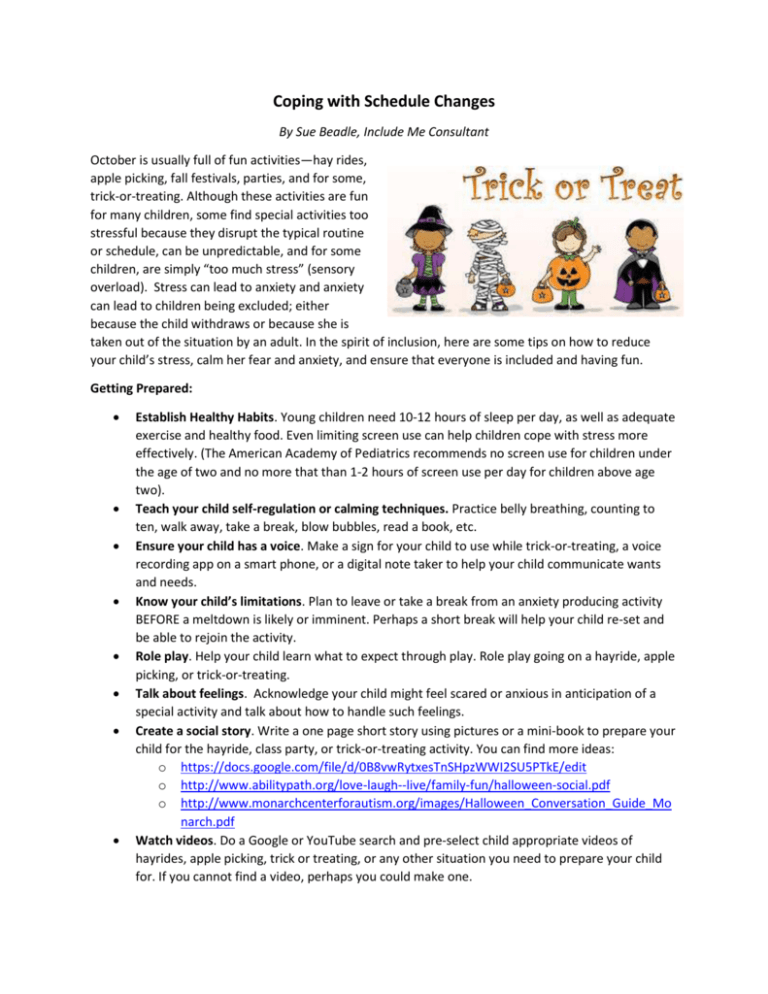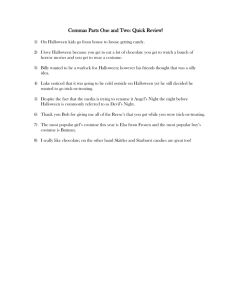Coping-with-Schedule-Changes-October
advertisement

Coping with Schedule Changes By Sue Beadle, Include Me Consultant October is usually full of fun activities—hay rides, apple picking, fall festivals, parties, and for some, trick-or-treating. Although these activities are fun for many children, some find special activities too stressful because they disrupt the typical routine or schedule, can be unpredictable, and for some children, are simply “too much stress” (sensory overload). Stress can lead to anxiety and anxiety can lead to children being excluded; either because the child withdraws or because she is taken out of the situation by an adult. In the spirit of inclusion, here are some tips on how to reduce your child’s stress, calm her fear and anxiety, and ensure that everyone is included and having fun. Getting Prepared: Establish Healthy Habits. Young children need 10-12 hours of sleep per day, as well as adequate exercise and healthy food. Even limiting screen use can help children cope with stress more effectively. (The American Academy of Pediatrics recommends no screen use for children under the age of two and no more that than 1-2 hours of screen use per day for children above age two). Teach your child self-regulation or calming techniques. Practice belly breathing, counting to ten, walk away, take a break, blow bubbles, read a book, etc. Ensure your child has a voice. Make a sign for your child to use while trick-or-treating, a voice recording app on a smart phone, or a digital note taker to help your child communicate wants and needs. Know your child’s limitations. Plan to leave or take a break from an anxiety producing activity BEFORE a meltdown is likely or imminent. Perhaps a short break will help your child re-set and be able to rejoin the activity. Role play. Help your child learn what to expect through play. Role play going on a hayride, apple picking, or trick-or-treating. Talk about feelings. Acknowledge your child might feel scared or anxious in anticipation of a special activity and talk about how to handle such feelings. Create a social story. Write a one page short story using pictures or a mini-book to prepare your child for the hayride, class party, or trick-or-treating activity. You can find more ideas: o https://docs.google.com/file/d/0B8vwRytxesTnSHpzWWI2SU5PTkE/edit o http://www.abilitypath.org/love-laugh--live/family-fun/halloween-social.pdf o http://www.monarchcenterforautism.org/images/Halloween_Conversation_Guide_Mo narch.pdf Watch videos. Do a Google or YouTube search and pre-select child appropriate videos of hayrides, apple picking, trick or treating, or any other situation you need to prepare your child for. If you cannot find a video, perhaps you could make one. Take a walk. A week before Halloween, take a walk (or several) around the neighborhood so you can gauge your child’s fatigue or endurance level. Make a plan. Plan out the trick-or-treating route. Ask your child to help you make a map. Trick-or-Treat at home. Your child may feel most comfortable at home but still wants to trick or treat. It’s not traditional to trick-or-treat at home but that’s ok. You can make your own Halloween traditions. Instead of going out, have friends and neighbors bring treats to your house for your child. Invite them for a specific time and if your child needs to know when to expect people to feel safe, tell her/him. You can make a picture schedule using photos you have taken in advance indicating the order in which they will most likely arrive. How to cope in the moment: Avoid rushing. If you are stressed, your stressed out child will find it more difficult to cope. Give yourself more time to accomplish a task so you can arrive early or on time. Model good coping skills. If you arrive late to a special event despite your best efforts, take a deep breath and let your child know it’s okay. (ex. “I wanted to be here earlier but it didn’t work out. It’s okay, we are still going to have fun.”) Follow the plan. Help your child be successful by setting limits and sticking to them. Sometimes children appear to be able to handle more of an activity. You may be tempted to let them go to “just one more house” or stay at the party for “just five more minutes.” Stand firm for the benefit of all. Your child is inexperienced in life and has not learned when to stop yet. She may seem to be coping just fine one minute, but her tolerance can break down without notice. Loud Noise. Teach your child to cover her ears when someone else screams. If your child tends to cover her ears AND scream, teach her to whisper a calming script (ex. “I’m okay. It’s almost over.” Or “It’s okay. The kids are just having fun.”). Control. Giving children control over certain aspects of the experience may help to reduce their stress. Allow them to check the visual schedule you have created, but try to stick to the plan. Allow your child to “veto” certain houses. You can come up with the veto list before hand and revisit it the night you go out to trick or treat to see if your child has changed her mind. Or, perhaps your child will want to “veto” in the moment. Allow it to happen and perhaps try again on the walk home. Try to avoid going out of order on the way home though. That will lengthen your trip and increase the likelihood of a meltdown. Follow some routines. End your day on a positive note by following your child’s bedtime routine. Ending a stressful day with predictable routines can help your child relax and remember and reflect on the good things that occurred during the day. Keep in mind. The more positive experiences your child has with stressful situations, the less difficult it will be for her the next time she is faced with a similar situation. The more negative an experience is, the higher the likelihood is that her response to stress will be more difficult to cope with in the future. Some ideas and tips were gathered from the following sources: http://www.monarchcenterforautism.org/about-us/visual-supports-dp1 http://www.napacenter.org/trick-or-treating-tips-for-parents-of-kids-with-special-needs http://www.psychologyfoundation.org/pdf/KHST_Booklet_for_Parents.pdf https://www.naeyc.org/files/yc/file/201107/Self-Regulation_Florez_OnlineJuly2011.pdf https://www.aap.org/en-us/advocacy-and-policy/aap-health-initiatives/pages/media-andchildren.aspx







